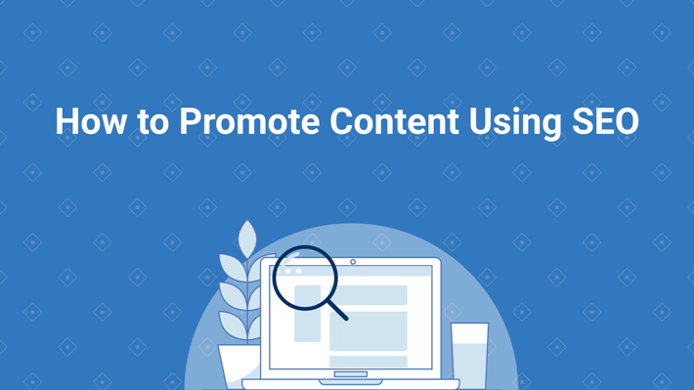Every time you create a new piece of content, you face a challenge: how to write text for people and yet optimize it for search engines.
We have great news for you—it’s possible to do both! In our article, we’re talking about the ways to create marketing materials that rank well with Google and stay appealing to people.
First of all, let’s see what SEO really stands for and why it’s so important for content promotion.
What Is SEO
Search engine optimization (SEO) is the practice of optimizing your online content so that a search engine shows it as a top result for searches of a certain keyword. In other words, SEO boost allows you to work on increasing both the quality and the quantity of website traffic, as well as the exposure of your brand, through organic search engine results.

According to BrightEdge, 68% of online experiences begin with a search engine. That’s an impressive number.
We all know that search engine optimization is vital but Google algorithms don’t stay still—they’re becoming smarter with every core update and enjoy reading your high-quality texts. After all, SEO is as much about people as it is about search engines. Content and SEO always go hand-in-hand. So, it’s about how to promote content and increase web traffic without spending too much on high-cost advertising campaigns, which is a good way to manage your marketing expenses. And understanding what people are searching for online, the keywords they’re using, and the type of information they need is the key to your success. You need this valuable data for all your marketing and sales content, for instance, to optimize your PDFs for SEO or create a high-ranking landing page.
At FlippingBook, we create software that converts PDFs into interactive HTML5 publications and hosts these publications online. And we always try our best to help our clients promote their content on the web and build their brand awareness in the most efficient way.
FlippingBook’s development and SEO teams follow all the latest trends and implement the new knowledge in the tech behind the publications. And they carry out different experiments to learn how to promote content and achieve business success.
Today we’re happy to share one of our experiments with you: we’ve created a flipbook, promoted it online, and analyzed the results. Below is what we’ve discovered—hopefully, it can be useful for every marketer out there.
Please note: We’ve carried out the experiment in January 2021. Since then the search results could greatly change.
Our Experiment
We created a flipbook called “How to Create an Ebook: a Step-by-Step Guide” and posted links to it on our blog, social media, Quora, and other resources.
Create yours
We knew that the topic was on-trend and it would require time and effort to rank high, but we took our chances, and (spoiler alert) we made it work!
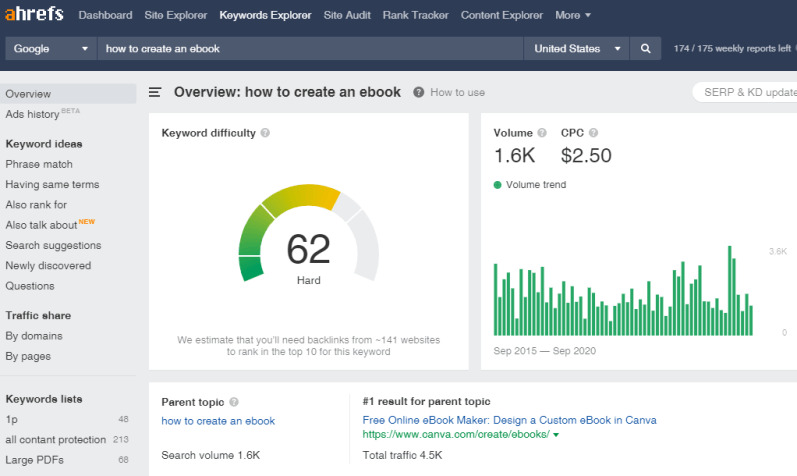
Within three days, all the pages of our flipbook were indexed and could be found on Google.
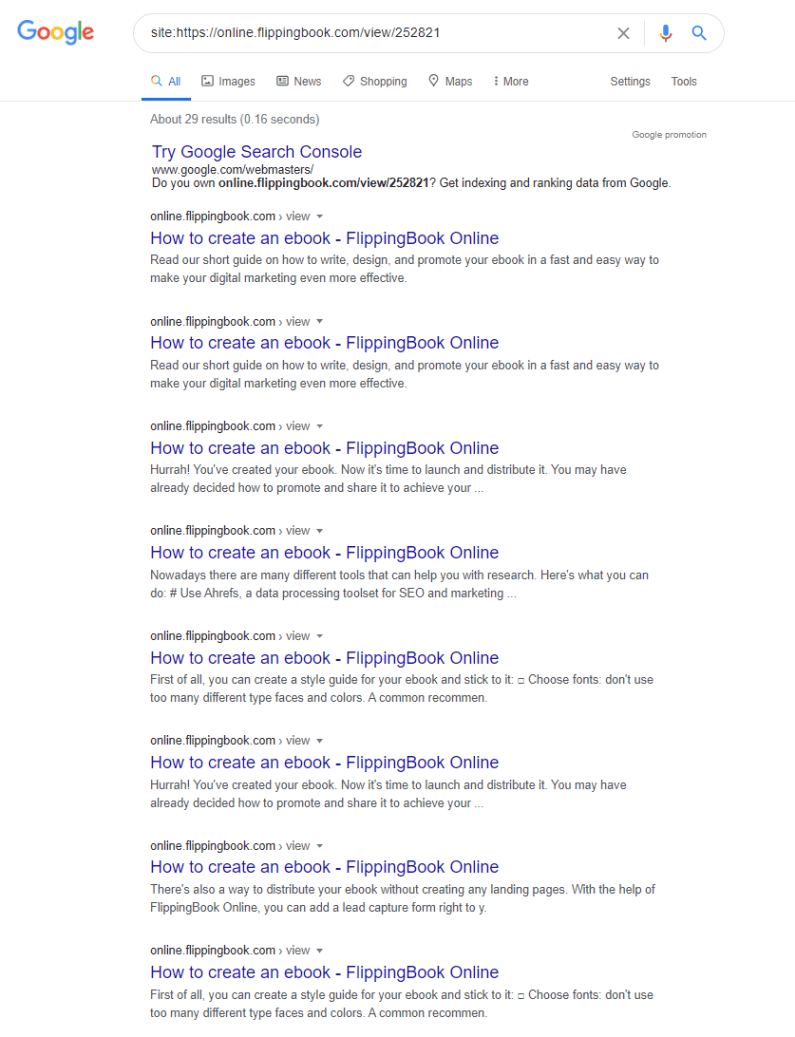
In five days after publishing our flipbook, we were able to find it on Google simply by typing random phrases from it.
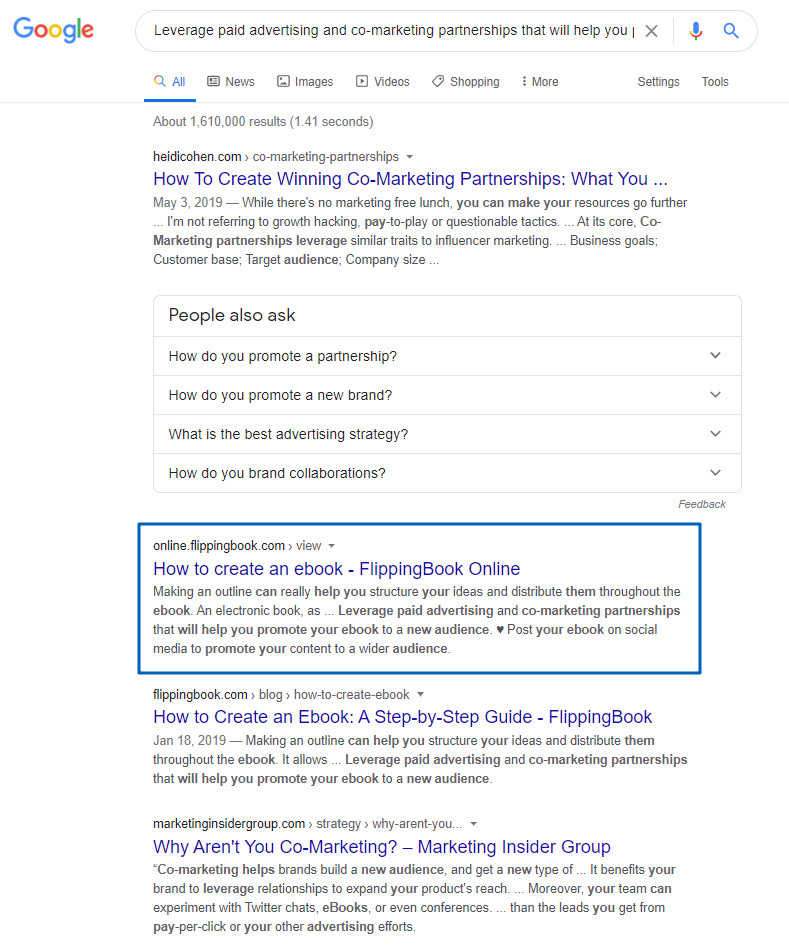
Plus, it could be easily found by the full name “How to Create an Ebook - FlippingBook Online”. The competition with our main landings was too strong but still, the flipbook appeared at the bottom of the first page on Google search.
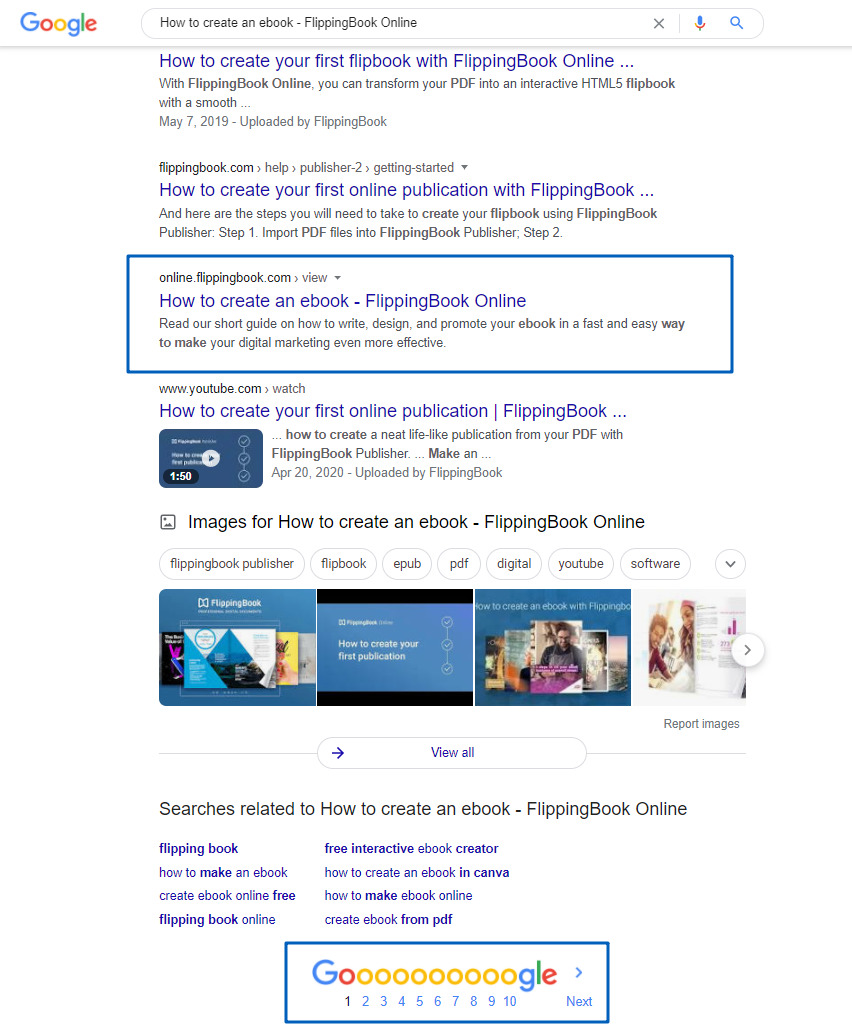
To avoid competing with our own landing pages, we decided to optimize our PDF flipbook for SEO and change the name to a more specific one—“How to Create an Ebook: The Ultimate Guide”. Only a week later it appeared on the first page.

Now it could be found by typing in the title plus any headline from the middle of the ebook, for instance, this one:

Google needed a bit more time to rank it higher but its starting points seemed great as well.
That was it!

How Flipbooks Can Help Promote Your Content and Boost SEO
If you want to both drive traffic to your website and promote your content in the form of a digital flipbook, brochure, ebook, catalog, or magazine, FlippingBook can be one of the most convenient ways to promote your content. You can sign up to FlippingBook Online or simply log in with your Google account. No need for any credit card details or anything to start—just choose the free trial, and you’ll be instantly redirected to your account.
Then upload the PDF you want to convert, and FlippingBook Online will do the rest. In a few minutes, you get a professional-looking flipbook ready for your content promotion activities. What's more, FlippingBook allows you to make your PDF SEO-friendly. Here's how you can switch on SEO and set relevant metatags for your flipbook.
How to switch on SEO for your flipbook
Your flipbooks are not indexed by search engines by default because we care about the security of your content. But if you decide to make your flipbook searchable on Google and other search engines, there’s a specific setting for it.
Here’s what you have to do to make your flipbook indexed by search engines:
- Open the list of your flipbooks.
- Hover over the flipbook you'd like to change, and choose the Customize option.
- You’ll be redirected to the Customizer where you set your flipbook to your liking.
- Go to the Privacy section and click on it to expand it.
- Select the option Public.

Don't forget to click Finish before leaving the Customize menu to save your settings.
*Please note that if you have a trial period, your flipbooks won’t be indexed even if you switch on this setting so that you feel secure when trying out our products.
How to set relevant metatags for your flipbook
Now, when your flipbook is open to be indexed by Google and other search engines, you can make it even more SEO-friendly by writing the relevant title and description for it.
Here’s how you can set custom title and description for your flipbook:
- In Customizer find the Title & Description tab and change them to custom ones.
- Click Finish before leaving the Customize menu to save your settings.
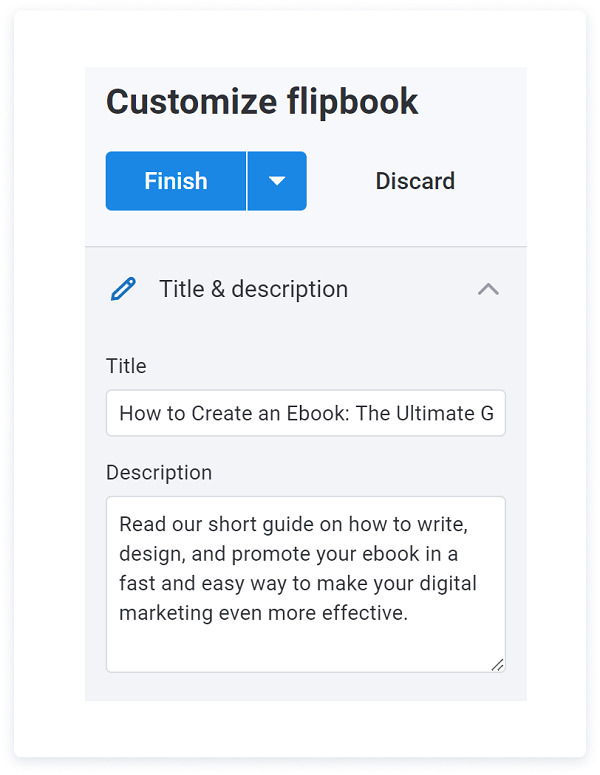
The Title is used as the title of your publication. Title and Description appear on search results if you make your flipbook searchable on Google.
According to Google, titles and descriptions of web pages are crucial to giving users a quick insight into the content and why it's relevant to their query. It's often the primary piece of information used to decide which result to click on, so make sure you use high-quality meta tags on your web pages.
Google also recommends differentiating descriptions for your web pages. Identical or similar descriptions on every page of a site or your flipbook aren't helpful when individual pages appear in the web results. That’s why we’ve developed our smart content promotion system that automatically creates a unique title and description for each page of your flipbook: it adds the number of the page to the title and a phrase from said page to the description (usually it’s the first phrase on the page, but if it’s not relevant Google will choose a more relevant one).
What’s more, when you create a new piece of content, you usually have to submit it to search engines to get indexed. With FlippingBook, you don’t need to do it because it’s done automatically with the help of our own sitemap.
How to Make Your Content Rank Even Higher
When you’ve successfully fine-tuned your digital materials and double-checked that all the required characteristics are met, you can take one more step to improve your search engine ranking. Yes, you’ve probably guessed it right—one of the best ways to promote content is backlinks, backlinks, backlinks.
Why are backlinks so valuable for SEO? Because they represent a "vote of confidence" from one site to another. They show search engines that your content is essential for other websites and that it’s worth linking to. So, earning backlinks can have a positive effect on a site's ranking position or search visibility. Here are two main opportunities for creating backlinks:
- Link building. It’s one of the most effective ways to rank on Google—a great method to increase views on new posts and reach a wider audience. You need to start by shortlisting sites that would be appropriate for your blog and then reach out to them to offer a link building partnership. Many marketers are open to this marketing strategy and will be glad to collaborate with you.
- Guest posting. Create a number of guest posts and pitch them to other sites that are relevant to your niche. Usually, you can include links in the content to the key pages on your site. Such backlinks help increase your brand awareness and popularity faster.
What’s more, if you want to keep ranking high, make sure that you update the content regularly. Here’s what you can do:
- Check your content for relevancy and update the info if it’s outdated. When you always provide your readers with fresh information, they will value you for this and will be getting back to you time after time.
- Update the keywords to make it easier for the readers to find your content.
- Monitor your search results competitors. If you notice that Google started ranking another website higher than you, you should explore what’s the difference between their content and yours. For instance, if your content became outdated or if you need to update the keywords.
Just remember that if your content isn’t updated regularly and is not relevant to your readers, it loses the ranking positions very fast. So add SEO checks and updates to your SEO plan to keep high-ranking positions and grow your business.
SEO is an awesome instrument to promote content and get the best results with it. When done right, it helps businesses achieve real goals for their success.
We hope that our article helped you see that SEO is not as scary or complicated as it may seem. You can start with the basic efficient tips and tricks which will work for driving traffic to your website, blog, flipbook, or online store, and for achieving high ranking in no time. Just go for it!
Try now

